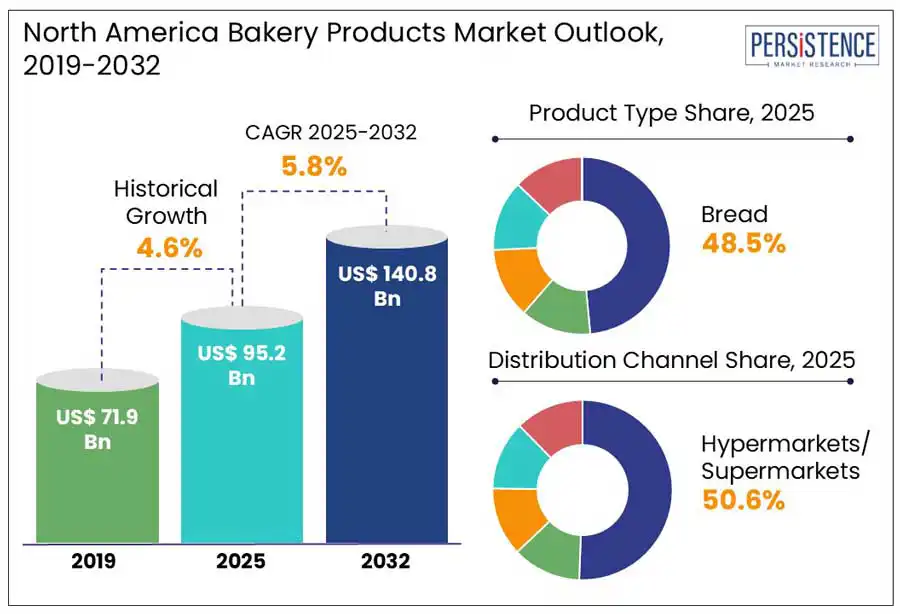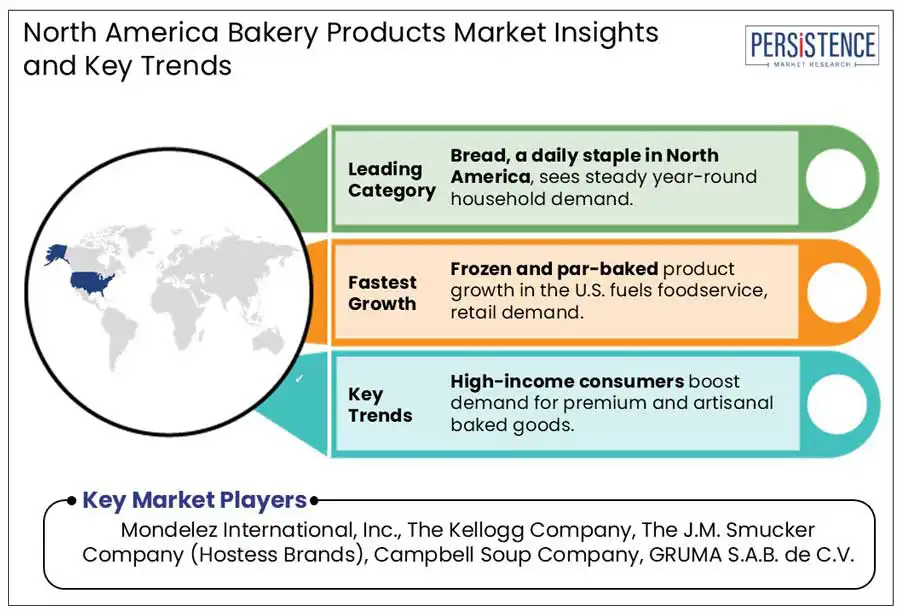Comprehensive Snapshot for North America Bakery Products Market Including Country and Segment Analysis in Brief.
Industry: Food and Beverages
Published Date: April-2025
Format: PPT*, PDF, EXCEL
Delivery Timelines: Contact Sales
Number of Pages: 120
Report ID: PMRREP35217
The North America bakery products market size is projected to rise from US$ 95.2 Bn in 2025 to US$ 140.8 Bn by 2032. It is anticipated to witness a CAGR of 5.8% during the forecast period from 2025 to 2032.
Renowned companies in North America are focusing on transparent ingredient sourcing and clean label products to cater to changing consumer preferences. The International Food Information Council (IFIC) found that nearly 16% of individuals in North America adopted a clean diet in 2022. Others followed plant-based diets (12%), calorie counting (13%), and mindful eating (14%). This trend has encouraged local companies to reformulate their bakery products by removing artificial additives and adding natural ingredients.

Key Industry Highlights
|
Market Attribute |
Key Insights |
|
North America Bakery Products Market Size (2025E) |
US$ 95.2 Bn |
|
Market Value Forecast (2032F) |
US$ 140.8 Bn |
|
Projected Growth (CAGR 2025 to 2032) |
5.8% |
|
Historical Market Growth (CAGR 2019 to 2024) |
4.6% |
Rising consumer preference for healthy and convenient on-the-go snacking options is a key factor projected to push the North America bakery products market growth. Rapid shift in consumption patterns highlight a surging awareness of calorie-conscious dietary choices and portion control. Key companies are capitalizing on this trend by launching small, portable packaging options.
Mondelez International, for example, found in its State of Snacking report that about 64% of consumers prefer snacking over conventional mealtimes as a regular eating habit. It has compelled brands to innovate their existing product lines. A notable example is the introduction of on-the-go Bouncers by Hostess Brands in 2022. These feature small snack cakes with cream fillings in three novel options, namely, cinnamon donuts, chocolate Ding-Dongs, and glazed Twinkies.
Even though bakery product demand in North America is expected to remain high in the foreseeable future, a few alternative snack formats providing more health benefits are likely to hinder growth to a certain extent. Consumers with busy lifestyles are gradually moving toward dairy-based snacks, protein-packed options, and snack bars.
As per a recent study, the snack bar segment exhibited around 7.8% year-over-year growth in 2023, whereas sales of packaged baked products declined, surging at less than 2.1%. It shows that today’s consumers are moving toward snacks that are ideal for active routines and more functional. Protein bars are predicted to gain momentum as a replacement for sweet bakery products, thereby hampering demand.
Increasing consumer preference for artisan bakery products is anticipated to create new opportunities in North America. Artisan bakeries are using various healthy ingredients such as natural sweeteners and whole grains to develop products appealing to younger consumers seeking premium and authentic bakery items. The American Bakers Association, for instance, revealed that about 90% of millennials and Gen Z customers have bought artisanal products such as tortillas, wraps, flatbreads, and pizzas.
Artisan bakeries often employ sustainable practices and source their ingredients locally, which lines up with rising interest of consumers in supporting homegrown businesses. These bakeries are now focusing on differentiating themselves from their competitors by delivering creative items and unique flavors that are otherwise difficult to find in mass-market bakeries. They are also adding nutrient-rich ingredients such as nuts, seeds, spelt, amaranth, and quinoa to improve the nutritional profile of their products.
The emergence of frozen bakery products is a leading trend in North America. Increasing demand for high quality, long shelf life, and convenience has led to the development of the frozen bakery products segment. Unlike conventional baked goods that face logistical challenges and have limited shelf life, frozen products provide high flexibility to both companies and consumers, making these appealing.
Hotel chains, Quick-Service Restaurants (QSRs), and foodservice operators are increasingly demanding frozen bakery products to manage labor shortages and supply chain issues. Products such as frozen cookie dough, par-baked sourdough, and sandwich buns help ensure standardization across different locations. Starbucks and Panera Bread, for example, utilize refrigerated or centralized frozen dough that is often baked on-site to lower reliance on skilled labor and ensure quality control at every outlet.
Based on product type, the market is divided into cakes and pastries, biscuits, bread, and morning goods. Out of these, the bread segment will likely generate a North America bakery products market share of around 48.5% in 2025. This growth is attributed to rising consumer demand for different types of breads such as artisanal, whole-meal, and ethnic varieties.
The segment is further projected to surge at a rapid pace with the increasing shift of millennials and Gen Z toward healthy bread options. Companies are hence focusing on incorporating ingredients such as ancient grains, whole wheat, and oats. At the same time, they are launching clean-label and fortified bread products that would appeal to health-conscious consumers. Bread’s high versatility in catering to multiple consumption patterns, right from specialty applications to everyday sandwiches, is another key factor propelling the segment.
Morning goods, on the other hand, are predicted to witness a considerable growth rate through 2032. Increasing consumption of indulgent food items and snacks as sensorial experiences, especially among the younger demographic, is poised to spur demand for morning goods. Rising preference for convenient breakfast items and trend for on-the-go consumption are also expected to bolster growth. Leading brands are striving to capitalize on this trend by launching unique varieties and new flavors of morning goods such as English muffins infused with essential nutrients, including manganese.
In terms of distribution channel, the market is segregated into hypermarkets/supermarkets, convenience stores, specialty stores, and online retailers. Among these, hypermarkets/supermarkets are estimated to account for a share of nearly 50.6% in 2025, finds Persistence Market Research. Diverse product offerings and large retail space are making hypermarkets/supermarkets the highly preferred choice for buying bakery products.
The presence of various well-known supermarket chains across North America such as Aldi, Albertsons Companies, Publix Super Markets, Inc., Walmart, Royal Ahold Delhaize USA, and Kroger Co., among others is another factor propelling this segment. These chains offer a wide variety of products from different brands under one roof. Surging demand for bulk purchases among modern consumers as they seek more value for their money with lesser trips to the store is further expected to accelerate the segment.
Convenience stores are presumed to remain in second position through 2032 with their strategic locations and extended operating hours. These stores provide quick buying options for various products, including baked goods. On the other hand, specialty stores are likely to gain popularity as these deliver premium and unique artisanal bakery products. These stores mainly focus on certain product segments such as donuts or cupcakes for high-end client bases.

The industry in the U.S. is anticipated to generate a share of around 66.2% in 2025 and remain at the forefront of growth. This is attributed to rising demand for health-oriented and clean-label bakery products. As per new findings, the sales of protein-enriched, gluten-free, and keto-friendly baked goods surged by more than 15% in 2023. Brands such as Hero Bread, Base Culture, and Simple Mills are hence extending their shelf presence across leading retailers, including Walmart, Target, and Whole Foods.
Production of allergen-free baked goods is also skyrocketing in the U.S. This is due to the rising prevalence of food allergies among individuals. The Food Allergy Research and Education (FARE) organization found that nearly 32 Million individuals in the country live with food allergies. It will likely spur demand for free-from baked goods. For instance, Partake Foods has witnessed triple-digit growth since 2020 with the launch of cookies that are devoid of the 9 main allergens.
Canada is poised to showcase considerable growth in North America bakery products market through 2032. Ongoing development of the foodservice sector in the country is expected to create new opportunities for bakery product companies. Restaurants Canada stated that in 2023, foodservice sales reached CAD 82 Bn in the country, which was a 13% surge over 2022. Baked products, mainly pastries, buns, and breads are considered key ingredients in baked desserts, burgers, and sandwiches, which is spurring demand.
Chains such as McDonald’s Canada, A&W, and Tim Hortons have either extended or reintroduced their baked goods lines including biscuits, cookies, and muffins to keep up with the high takeaway and dine-in traffic. Tim Hortons, for instance, serves more than five million baked products every day. Its limited-edition baked products and Dream Donuts have been a prominent part of its promotional strategy.
The North America bakery products market is highly competitive with the presence of several large- and medium-sized companies. Leading companies are focusing on launching innovative products with distinct flavors and ingredients to attract a large consumer base. A few other players engage in collaborations, mergers and acquisitions, and facility expansions to strengthen their position across North America.
|
Report Attribute |
Details |
|
Historical Data/Actuals |
2019 - 2024 |
|
Forecast Period |
2025 - 2032 |
|
Market Analysis Units |
Value: US$ Bn/Mn, Volume: As Applicable |
|
Geographical Coverage |
|
|
Segmental Coverage |
|
|
Competitive Analysis |
|
|
Report Highlights |
|
|
Customization and Pricing |
Available upon request |
By Product Type
By Distribution Channel
By Country
To know more about delivery timeline for this report Contact Sales

The North America bakery products market is projected to be valued at US$ 95.2 Bn in 2025.
Increasing demand for clean-label products and surging number of artisan bakeries are the key market drivers.
The North America bakery products market is poised to witness a CAGR of 5.8% from 2025 to 2032.
Emergence of frozen baked goods and inclusion of healthy ingredients in existing products are the key market opportunities.
Mondelez International, Inc., The Kellogg Company, and The J.M. Smucker Company (Hostess Brands) are a few key players.